Please don’t call me Ishmael. This account does describe “sailing about a little and seeing the watery part of the world.” And it involves a quest for a white whale. But the boat is not Pequod. Nor is there a vengeful, one-legged sea captain. Oh, and don’t go looking for detailed descriptions of cetacean penises. Or penises of any sort. It’s not that kind of story.
Tadoussac and the Saguenay
The village of Tadoussac, Quebec, was a highly anticipated destination for us last summer. Located at the confluence of the St. Lawrence River and the Saguenay River, Tadoussac is a little over 100 nautical miles down the St. Lawrence River from Quebec City. Locals call the river by its French name, le fleuve Saint-Laurent. We arranged to rendezvous at Tadoussac with our sailing friends Frank and Marie-Claude (S/V Komeekha), then cruise up the Saguenay which is renowned for its scenery and its whale watching opportunities. Tadoussac has been an important meeting and trading site for Native American tribes for 8,000 years. The village dates to the early 1600s when French traders set up a trading post there. Tadoussac is the oldest surviving French settlement in Canada.
The name is thought to be derived from an Innu (First Nation) term comparing nearby hills to women’s breasts (much like the Grand Tetons mountain range in Wyoming conjured large bosoms to early French trappers.) Besides a replica of the old trading post, Tadoussac offers numerous restaurants, a vintage grand hotel and a must-see oceanic mammals museum.
The Main Attraction
Tadoussac’s main attractions are its access to prime whale watching water on the St. Lawrence River and the Saguenay fjord. It is also the heart of the Saguenay-St. Lawrence Marine Park, a Canadian national park dedicated to the study and protection of marine life and the ecosystem of the St. Lawrence and Saguenay rivers. Some 200,000 people visit Tadoussac annually to watch whales in the summer months. Ten species of whales visit or inhabit these waters, as well as dolphins, seals and loads of fish and other sea creatures farther down the food chain.
The Saguenay, pronounced “sag’ un ee” by the locals, is in a rift valley that starts 150 miles north of Tadoussac. At 65 miles, the Saguenay fjord is one of the longest fjords in the world; its spectacular cliffs and deep water attract visitors from around the world who boat, kayak and hike the area. The deep water provides an ideal calving environment for full-time resident St. Lawrence Beluga whale. These whales are isolated from Belugas found in the Arctic Ocean and northern reaches of the Atlantic and Pacific oceans. Belugas are the stars of the show, with their ghost-white skin, bulbous head and complicated communications which include chirps and whistles. The are affectionately called the “canaries of the sea!” For all their currently popularity, they are still recovering from an effort begun in the 1920s to exterminate them. Belugas were blamed for declining commercial fish populations–cod and salmon in particular. The government of Quebec stepped in with a bounty on Belugas, then even began bombing them. They are very social animals and often travel in pods of a dozen or more individuals; bombing pods was an efficient way to reduce their numbers.
Protecting the Belugas
In the 1930s somebody finally got around to studying Beluga eating habits and discovered their diet consisted of mostly smaller fish and did not impact the commercial fish populations. By then the Beluga population was reduced from an estimated 10,000 individuals to mere hundreds. They were on the verge of extinction. The governments of Quebec and Canada entered into studies and then agreements that culminated in the establishment of the first marine sanctuary and park in Canada 1998. It covers 480 square miles around the St. Lawrence and Saguenay intersection. Recent studies indicate the St. Lawrence Beluga population to be around 1,800 whales–they have a long gestation and mothers nurse calves for three years, so repopulation is a slow process. Our expected arrival happened to coincide with the start of the Beluga calving season!
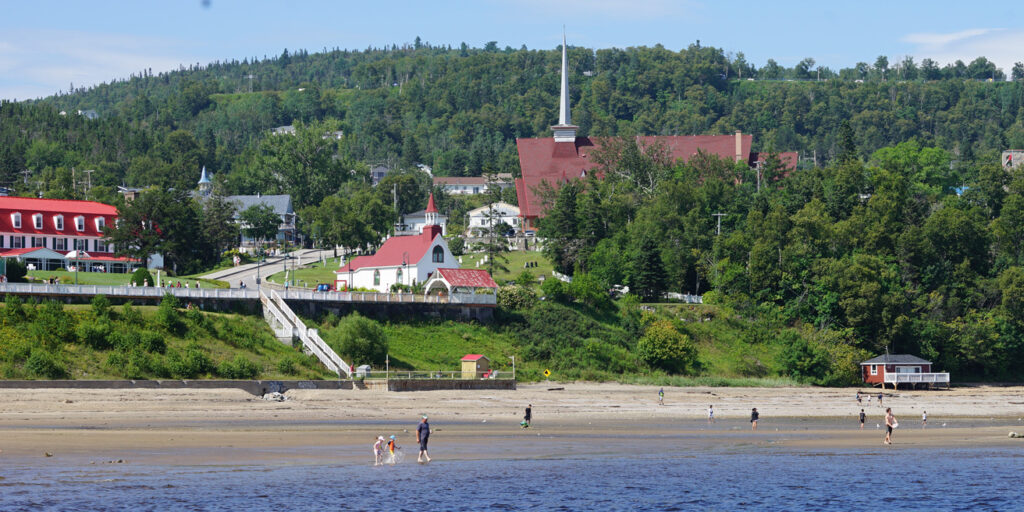
Baie de Tadoussac
The village of Tadoussac sits around a small bay at the mouth of the Saguenay River. The whale watching boats we witnessed on our way in came out of that bay. The harbor includes a 100-boat recreational boat marina and commercial boat docks at the entrance. The commercial boat docks berth most of the whale-watching fleet.
Deep-keeled boats access the marina from the Saguenay estuary via a narrow channel along the end docks. Thirty-foot bluffs above a grey sand beach arcs from just beyond the marina to the northeast shore. The beach ends in a rocky shoreline one-third mile across from the end of Islet Point, which is what they call the short peninsula that separates the bay from the estuary and river. The water depths inside that vector are about three feet at low tide. Water farther out from that line is deep enough to safely anchor.
Pump-out v1.0 – Fail

We planned to pump out our holding tank in Tadoussac; our last pump out occurred when we arrived in Quebec City. We soon learned that the marina’s sewage pump-out station was out of service. The part needed to restore service would arrive “any day now,” according to a dockhand, who added, “un espere.” That’s French for “one hopes.” Since they had already been expecting the needed part for weeks already, a very Gallic shoulder shrug accompanied the comment. Later, the harbormaster assured us that a marina up the Saguenay would be able to pump us out. That was hardly reassuring considering we were expecting guests and would be departing Tadoussac with a holding tank that was possibly half full.
The rest of the day was spent cleaning and preparing Gaviidae for Frank and Marie-Claude to join us. Meanwhile, people poured into Tadoussac. The weather was gorgeous–warm and sunny—and the weather forecast was for more of the same. The road and sidewalks along the harbor filled with cars and people. We also saw people wearing bright orange storm suits lined up to board the bright orange whale watching boats. More boats arrived at the marina, and we noticed several anchored or moored in the bay. One small sailboat anchored near the beach and deployed boards to stabilize it as the tide ebbed and the boat rested on its keel!
Happy Reunion!
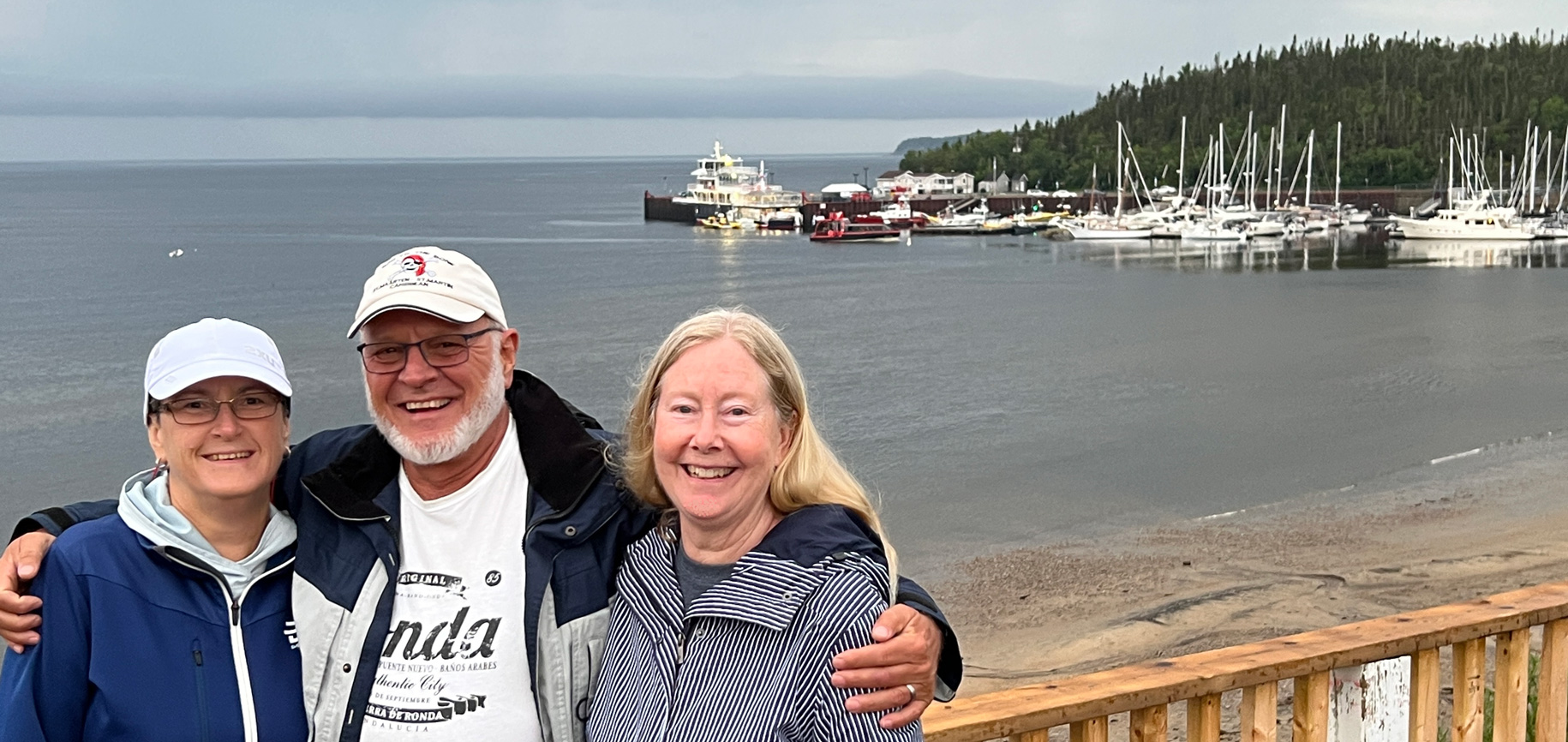
The rising tide of people into town didn’t dampen our excitement at reuniting with our friends. We last saw each other the previous summer when we rendezvoused at the Bayview Marina in Sarnia, Ontario. They were on their way to the Caribbean; we were going as far as the Thousand Islands at the east end of Lake Ontario. When they passed through Tadoussac later that summer, winds howling down the Saguenay fjord prevented them from exploring that legendary waterway. They were joining us at Tadoussac for an overdue reunion, and to get another shot at a cruise up the fjord.
Frank and Marie-Claude arrived Friday afternoon and parked in a loading/unloading zone next to the marina. After unloading a couple bags of clothes and food and beverages from their car, Frank went in search of long-term parking. He scored the last spot in a parking lot near the marina. Because of the crowds, we went looking for an early dinner. We struck out at the first couple of eateries along the restaurant row facing the harbor but lucked into a table at one of the better—and quieter—dining venues farther along the waterfront street.
Sugar Sugar
The next morning, we awoke to cloudier skies than expected. Donning rain jackets—just in case–we hit the local farmers market and the village’s one grocery store to provision for a weeklong cruise. Marie-Claude found a tarte au sucre Sugar Pie! Made mostly of sugar, maple syrup and butter, this traditional Quebec treat is sweet enough to prompt the dental version of a brain freeze. Once she learned we had never had Sugar Pie, it was a mandatory purchase.
Early that afternoon we departed Tadoussac on the high tide and cruised up the Saguenay estuary and through the channel between high bluffs: The beginning of the Saguenay fjord. The channel features a 60-foot-deep shoal called a sill. We crossed the sill into the first of three ultra-deep basins that make the Saguenay hospitable for sea creatures. These basins were created during the last ice age by mile-high glaciers that collapsed and crushed the underlying rock. The glaciers followed an even more ancient rift valley called the Saguenay Graben. The Saguenay Graben was formed millions of years ago when continental drift was a thing and the earth’s crust was colliding and buckling and forming mountains that then collapsed or eroded away as great seas rose and ebbed over countless millennia.
Dark Skies over the Saguenay

The high tree-covered bluffs surrounding the basin were dark and increasingly ill-defined in the distance under the lowering grey sky. The water was a cold, forbidding dark green. The scenery was impressive, but we had a more pressing task: watch for St. Lawrence Beluga whales.
As we headed up stream, the skies lightened somewhat but we saw no white whales. A couple hours into our journey we were approached by a Quebec fisheries boat. The officers aboard instructed us to stay to the west half of the river because the pregnant Belugas birthing in the deep, cold waters of the Saguenay hang out with their babies in the eastern part of the river. We were also told not to approach a whale, but to continue on a steady course if a Beluga should appear front of the boat. The wardens then gave us some reading material including a very handy whale identification guide.
We arrived at our destination, Ile Saint-Louis (St. Louis Island), a little after 5:00 and dropped anchor off the south end of the pretty evergreen-covered island. We hadn’t seen any white whales that day, but we were greeted by seals and a couple of loons. It was such a lovely spot that we opted to stay two nights. Other boats cruised by also seeking anchorage in this desirable location. We spent the time catching up on our travels and adventures. Evenings we ate Sugar Pie while playing Farkle – all with plenty of adult beverages!
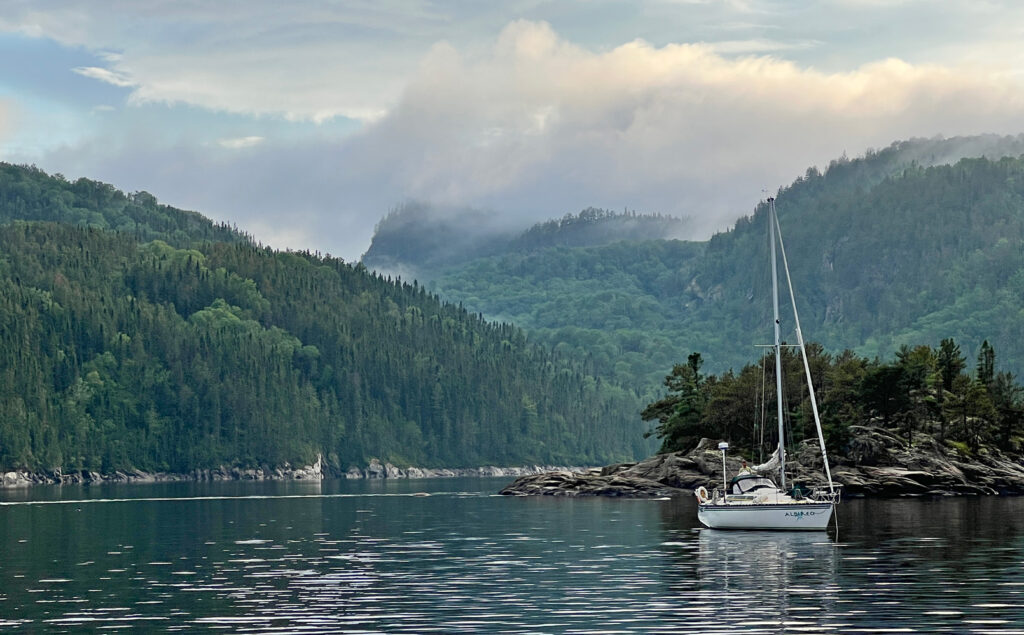

Pump-out v2.0 – Fail
On Tuesday we made for the l’Anse de Saint Jean (St. Jean Cove), where we planned to get the overdue pump out and an overnight slip at the local marina, Club Nautique Anse-Saint-Jean. The village there, Saint-Fiacre, was reported to be charming, and nearby hiking trails were another attraction. As we cruised into the bay, we contacted the marina only to learn that they did not have hose fittings for the pump out! This was a first for all of us. Every marina pumping station we had ever visited had fittings on hand to connect to the array of holding tank ports found on boats from around the world. Since we do not carry a pump-out fitting for Gaviidae, we turned around and sailed on to La Baie and a marina 30 nm up the Saguenay.
Wild Beauty
While the scenic views of our first day on the Saguenay were diminished by overcast skies, the sights along the fjord upriver from Ile Saint-Louis were stunning. The bluffs were higher, more abrupt and seemed more imposing as the river narrowed and widened and narrowed again. The granite and schist rock walls shimmered and sparkled in the bright sunlight. Waterfalls gracefully cascaded down bluffs and splashed over cliffs, creating small rainbows arcing across mists. We were beyond the prime Beluga habitat, so we had more time to admire the sheer rugged beauty around us.
Ha! Ha!
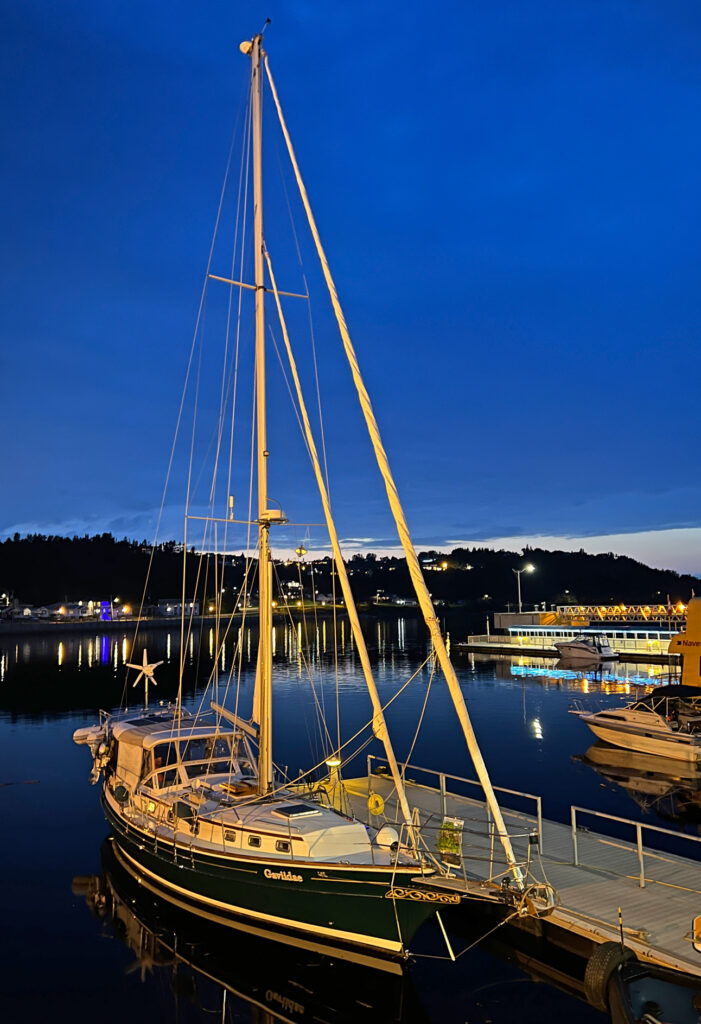
Our destination was the port of La Baie, part of a small metro area near the end of the navigable section of the fjord. La Baie sits at the west end of the curiously named Baie des Ha! Ha!, an arm of the Saguenay River. The origin of the name Ha! Ha! is uncertain; it may derive from an obscure First Nation term, but it resonated with us.
This time we called ahead. The harbormaster at La Baie Marina was able to assign a slip but informed us that the pump out station was out of service! Despite his assurances that the pump out station would be back in service the next day and that he had fittings for the pump out, we were beginning to panic. We already knew that service and parts for les vidanges sanitaires in Quebec were unreliable. All hands were instructed to use facilities ashore until we emptied that tank of its contents.
La Baie
We arrived at the marina at 1900 (7:00 p.m.) and discovered the promised slip was occupied! A large powerboat had come in after hours and the skipper took the last space available for a boat over 40 feet long. Our slip. A couple of phone calls later and the harbormaster showed up and backed a small trawler tied to the dock closest to the interior harbor wall farther into the slip. We were expected to park in front of the trawler. It was a narrow space and the bay was at low tide at the time. To get into the spot created for us, we had to negotiate around some boulders in the process and note their location for our departure if the water level was higher.
Pump-out v3.0 – Success!
The kerfuffle over the lost slip did not enhance our confidence about the promised repair to the pumping station. Our best options were to sit tight and hope for a timely service or contact another marina across Ha!Ha! and further upstream in the city of Saguenay. We began to think the bay was laughing at our dilemma. Fortunately, our concerns were relieved the next morning when the pump was successfully repaired, and our holding tank got emptied right away. And because of our location, we did not even have to move for the pump-out!
That day we explored part of the town within walking distance. It didn’t have much to offer as many of the businesses had been shuttered since 2022 and COVID-19. We had dinner at a nearby restaurant-brasserie.
Baie Éternité
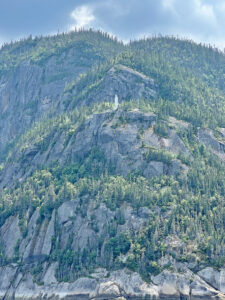
We departed La Baie the following morning at high tide and made for la Baie Éternité (Eternity Bay), almost halfway back towards Tadoussac. This one-mile-deep bay on the west side of the Saguenay River is where the Eternity River empties into the fjord. The bay marks the Saguenay’s deepest basin of 1,549 feet.
At the northeast corner of the bay is Cap Trinité, with its imposing cliff face and the 27-foot statue of Notre-Dame-du-Saguenay. This statue is made from white pine encased in thin sheets of lead. It weighs over three tons and had to be separated into 13 pieces to be hauled up to its platform in 1881. The statue commemorates the legend of a travelling salesman who fell through the ice while trekking up the frozen river and survived after praying to the Virgin Mother. It is a major cultural landmark along the fjord.
Deep Anchorage
The bay is quite beautiful, and the water is very deep right up to its rocky shoreline. It is notorious for its lack of places to anchor unless you have a couple hundred feet of anchor rode. We carry over 200 feet of chain, but we managed to drop our hook on the only 20-feet-deep shoal midway down the north side of the bay.
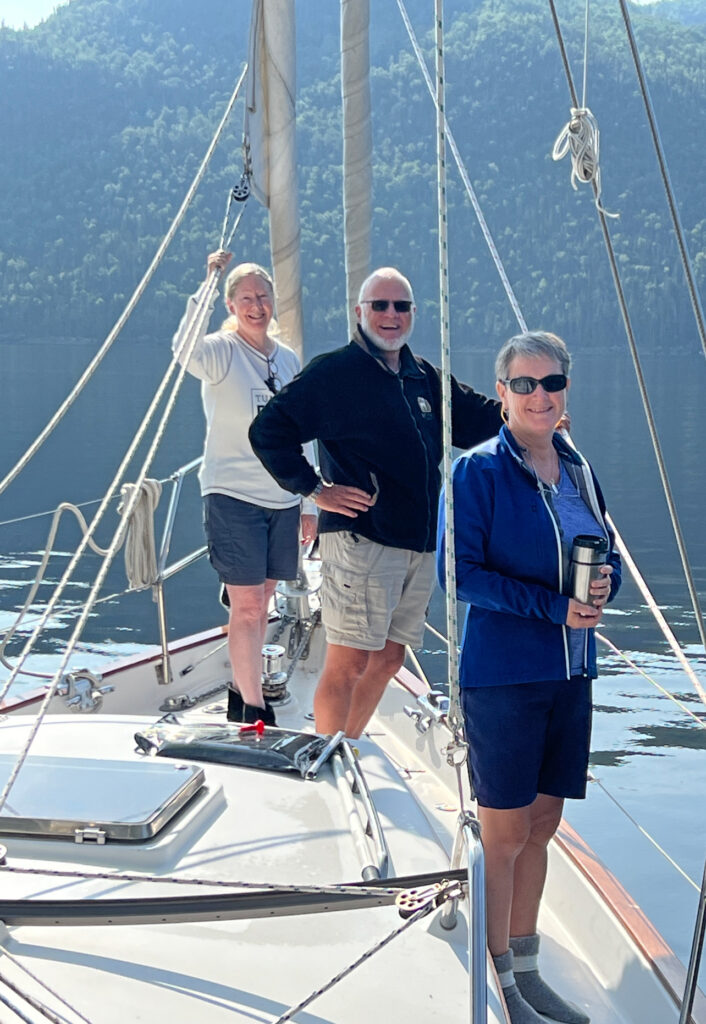
We stayed two nights and shared the huge bay with only three other boats, including a 110-foot sailboat called Fair Jeanne which arrived on the second day. Fair Jeanne is a rather famous training sailboat we crossed paths with a couple of times on our journey down the St. Lawrence River. We first encountered this traditionally rigged brigantine in mid-June in Brockville, Ontario, where it was being readied for a summer cruise down the St. Lawrence. Once their anchor was settled, the kids onboard used the halyards to swing into the chilly water, with lots of shrieks and hollers! A real live bay of ha-has. At the same time we were buzzed repeatedly as one of the kids played with his racing drone, swooping it around us and the other boat in the anchorage.
Belugas!
We left Baie Éternité the next day (Friday) as Frank and Marie-Claude needed to leave for Quebec City on Saturday. Hopeful and vigilant as ever for a whale sighting, we finally got our “thar she blows” moment as we passed Ile Saint-Louis shortly before noon. A sliver of bright white appeared between us and the eastern shore about a quarter mile away! Then someone spotted another! And another! And then a cluster of white slivers appeared simultaneously! The Beluga were popping up on the surface of the river like popcorn in a hot pan!
We grabbed binoculars and a camera with a telephoto lens. With the magnification, we could make out small white cloudbursts above the slivers. Beluga spouts! Then we began spotting small grey forms alongside some of the white slivers. Beluga calves! Our photo efforts proved disappointing as we were just too far away. We got very few images that weren’t blurred, out of focus or simply lacking in details. We were, after all, still on a boat cruising at six knots. The fisheries officers we talked to a few days earlier told us to maintain a speed of between 5-10 knots. Since it was calving season, we took their instructions quite seriously.
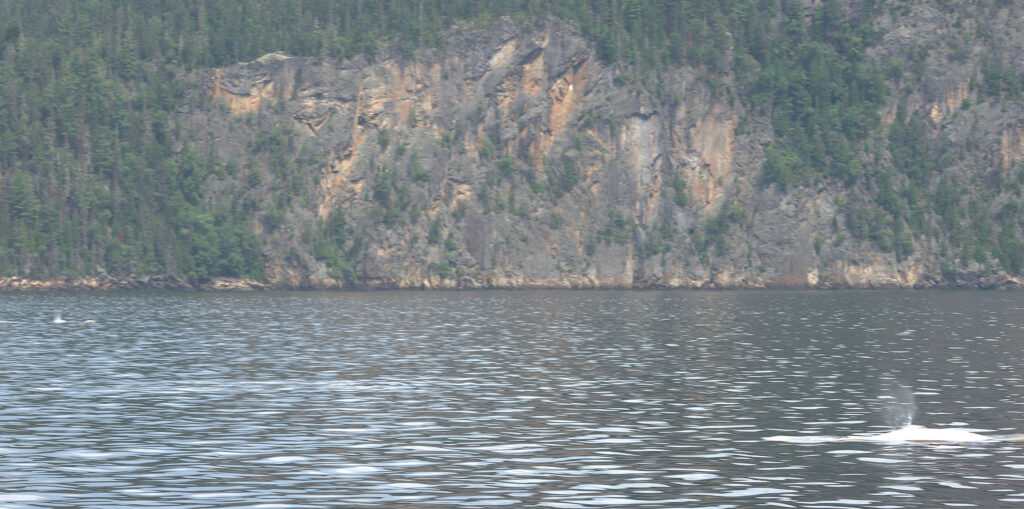
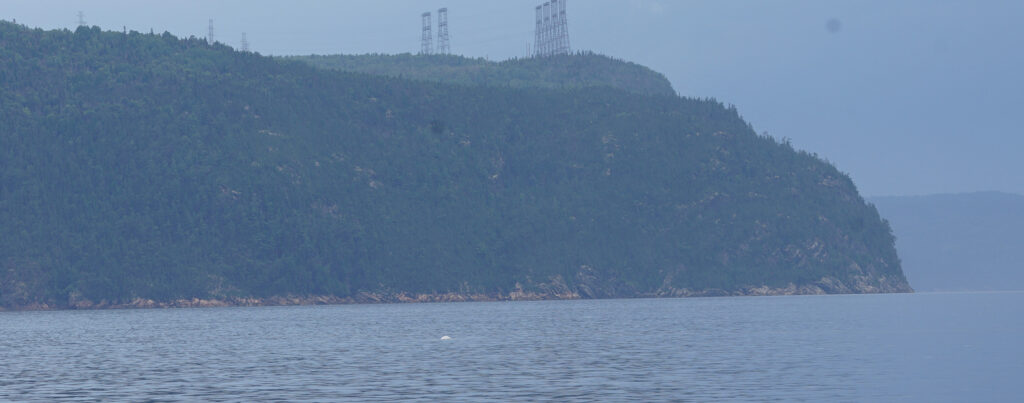
We continued to spot Beluga popcorn for the next 12 nautical miles until we approached the end of the high cliffs and crossed the sill that denoted the mouth of the river and the beginning of the estuary.
Back in Tadoussac
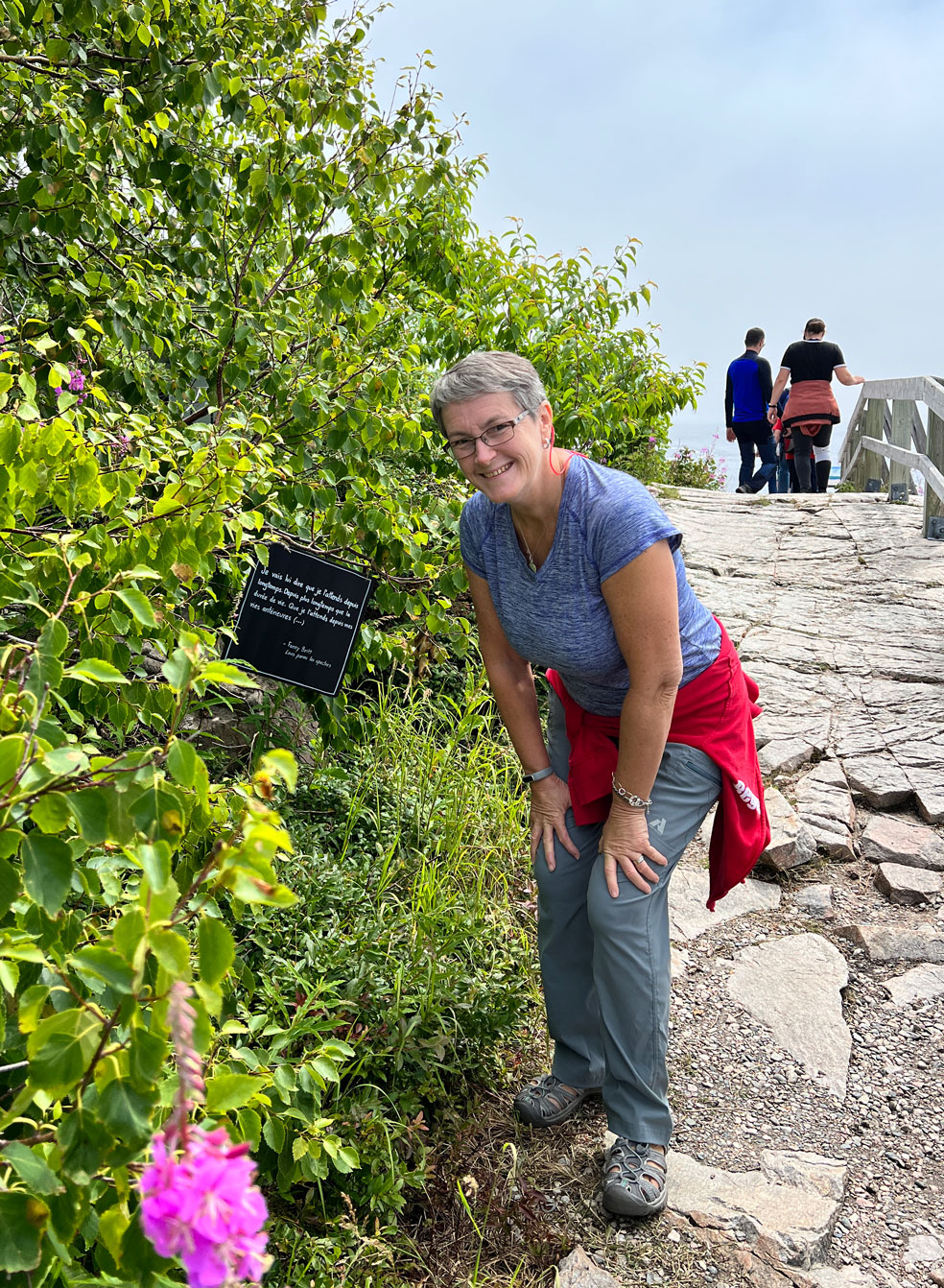
Our weeklong quest in search of the mighty Beluga was an unqualified success. After we tied up at the Tadoussac marina, the four of us walked over to the Marine Mammel Interpretation Centre. There we learned more about whales and seals and other oceanic fauna than our aging brains could possibly retain. In English and in French. The nature museum included assembled cetacean skeletons—see, some of that information was retained!—assorted exhibits and videos and an excellent bilingual presentation by museum docents.
After a couple of well-spent hours in the interpretation center, we went for a hike along the Islet Point peninsula and were astounded to see even more white slivers heading from the Saguenay delta toward the mouth of the river. In addition, we saw flukes and spouts of other types of whales, as well as dolphins leaping out of the water and seals barking and lounging on the rocky shore. It was a very gratifying conclusion to an amazing week.
Au revoir
The next morning, Marie-Claude (with assistance from Frank) made eggs poached in maple syrup–a fabulous Marie-Claude creation we enjoyed on a previous sailing adventure. After breakfast we all went to farmers market and the grocery store to reprovision for the next phase of our cruise on the St. Lawrence Seaway. That afternoon we bid farewell to our friends after they collected their gear from the boat and saw them off to Quebec City. It was sad to see them go not only at losing their excellent companionship, but knowing that because Komeekha was in the Caribbean, it could be a couple of years before we would see them again.
So that concludes our little whale tail. We sailed a beautiful part of the world, found our white whales and had a great time with good friends. And while Ishmael only escaped alone to tell his story, everybody on Gaviidae lived to tell the story.
July 30, 2023 595.9 Nautical Miles 48°08.316’N 069°42.918’W

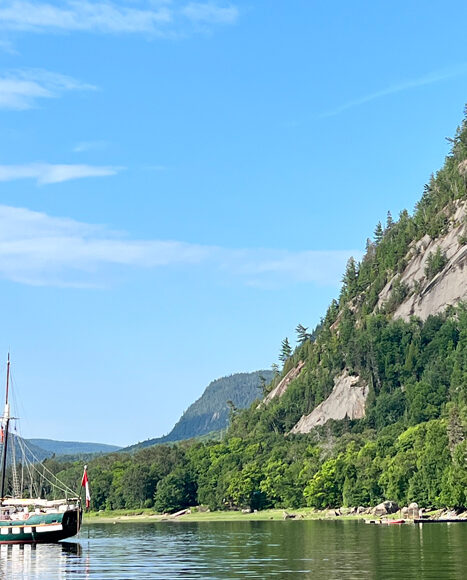
Dan and Julie,
I enjoy reading about your adventures due to my special connection with your boat. I am the son of the previous owner and haves forged many wonderful memories sailing then Frances in the waters around Rhode Island. Inspired in part by your adventures, my wife and I plan on having our own boat shipped to Duluth for a two season voyage back to RI. I am reaching out in hope that we can establish a dialogue to tap into your knowledge of the Great Lakes. Most specifically at present, I am hoping to learn about services in Duluth. Thank you for sharing your experience.
Hi Matthew,
Sounds like an adventure in the works! Sending you a separate email.
D&J
I have written two comments and they disappear. Luckily your writing does not. Thank you for sharing so much. Envy your travel. Keep writing as your stories keep me entertained. Hugs. Ilona
Hugs to both of you!!
Thank you for your excellent writing! Memories will be yours forever.
Thank you for sharing your wonderful adventures A joy to read each segment.
Roy
Thank you Roy – have fun at the Toronto Boat Show!
Thanks SO MUCH for including me in this great adventure!!! I spent a lot of time in the Quebec area (on land) and fell in love with the French Canadians! They were so friendly and welcoming! It is my favorite area of Canada to visit! Thanks for taking me along with the other areas! I’m moving back up north to Baltimore for work and look forward to the 4 seasons! Been in Florida since 2015 and burned out – did all there is to do here and ready to move on and look forward to sailing in the Chesapeake Bay! Haven’t sailed since before COVID!! I miss it! Still a member of FREEDOM BOAT CLUB.
I look forward to hearing about your next adventure! Your boat is AWESOME!!!
Melanie Frey
Thank you Melonie – look for us on the Chesapeake next fall!